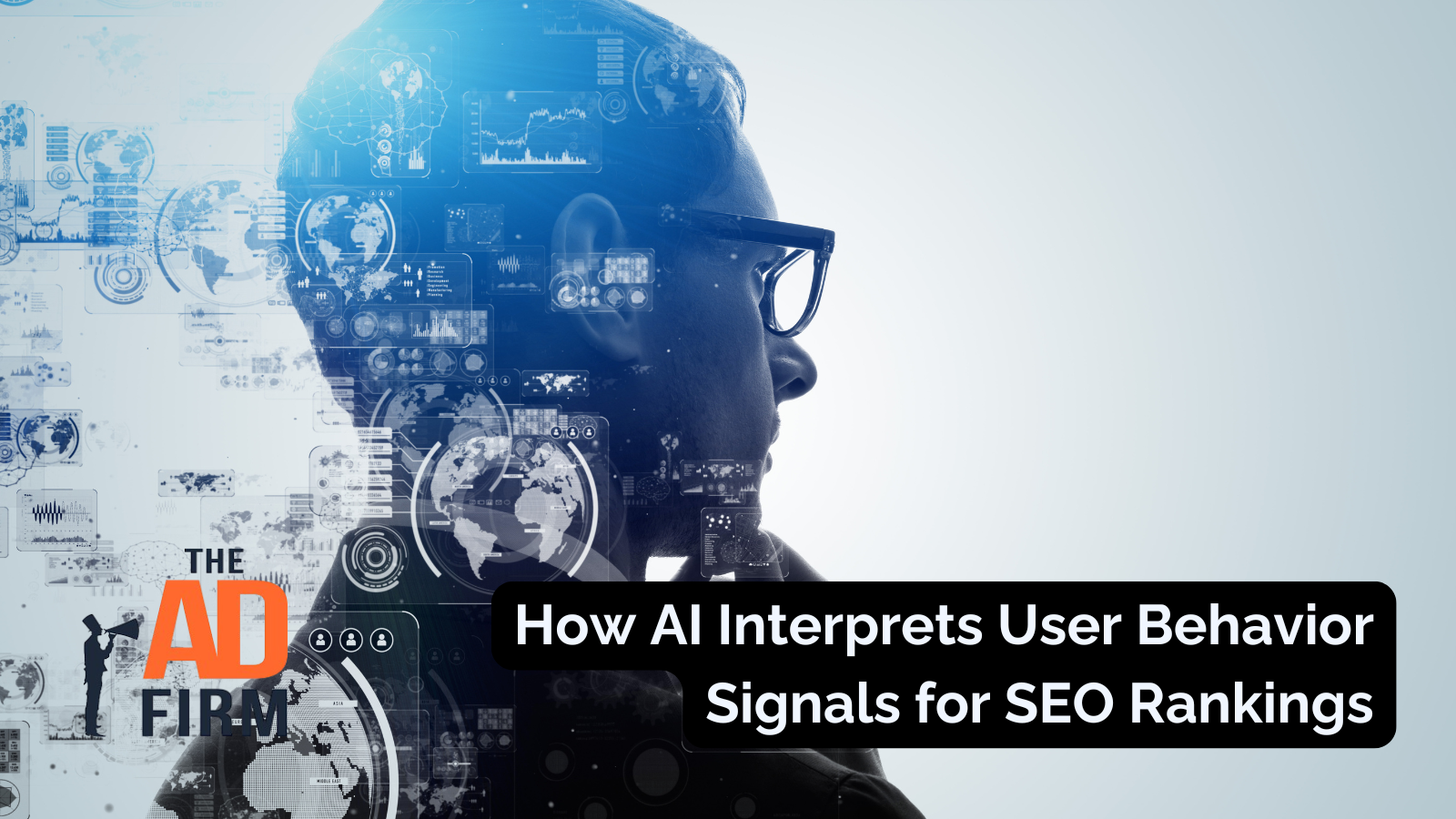As Google’s search algorithms continue to evolve, businesses face the challenge of keeping up with how content is ranked. It’s no longer just about keywords. Google’s AI is now focusing on how users interact with websites to measure relevance.
For businesses looking to improve rankings, understanding how AI interprets these user behavior signals is more critical than ever.
To help you thrive in these changes, we’ll break down the key behaviors AI tracks, including click-through rates, bounce rates, and time on page, and explain how they influence your SEO performance.
We’ll also highlight how working with an experienced SEO company can help you make sense of these signals and adjust your strategy to align with Google’s evolving standards.
Let’s get into it.
What User Behavior Does AI Track for SEO Rankings
Google’s AI tracks several critical user behavior signals to help determine how well a webpage meets user intent. By analyzing these behaviors, AI can assess whether users are satisfied with the content, whether they find it useful, and how likely they are to engage with it again.
The goal is to match the most relevant content with the searcher’s query, ensuring a satisfying user experience.
To give you a deeper understanding, the primary user behaviors that AI monitors include:
- Click-Through Rate (CTR): The percentage of users who click on a link after seeing it in the search results.
- Bounce Rate: The percentage of visitors who leave your site after viewing only one page.
- Time on Page: How long users spend on a page, reflecting content engagement.
- User Engagement: Metrics like comments, social shares, and interaction with multimedia elements.
- Return Visits: How often users return to your site after their first visit.
Google’s AI interprets these signals to understand whether your content aligns with user intent. High levels of engagement and low bounce rates indicate that your content is valuable and relevant to users.
Understanding these behaviors is crucial to enhancing SEO performance, as Google prioritizes pages that meet user expectations.
How AI Reads and Analyzes User Behavior Signals for SEO Rankings
Google AI tracks user behavior signals, such as click-through rates, time on page, and engagement, to shape search rankings. Understanding how these signals function is crucial for optimizing your content for improved SEO.
Boost Your Business Growth with The Ad Firm
- PPC: Optimize your ad spends with our tailored PPC campaigns that promise higher conversions.
- Web Development: Develop a robust, scalable website optimized for user experience and conversions.
- Email Marketing: Engage your audience with personalized email marketing strategies designed for maximum impact.
Let’s look at how they’re processed and what they mean for your site’s performance.
Click Through Rates and Bounce Rate Analysis in Google Rankings
Click-through rate (CTR) and bounce rate are key indicators that Google uses to evaluate content relevance. A higher CTR indicates that users find your content appealing and relevant, which can lead to improved rankings.
If users click on your page and quickly leave (a high bounce rate), it suggests the content didn’t meet their needs, which can negatively impact rankings.
Google’s AI processes these signals to determine whether your content matches user intent. For example, a low bounce rate combined with a high CTR indicates that your page is effectively answering the user’s query. If the opposite occurs, Google may adjust rankings to favor content that better satisfies search intent.
In addition, as AI shifts towards understanding vector search, it becomes more adept at identifying more profound contextual relevance. Understanding how users interact with your content helps ensure that your pages are aligned with their expectations.
Time on Page and User Engagement Metrics That Matter Most
Time on page is a direct reflection of how engaging and relevant your content is. The longer users stay on your page, the more Google interprets this as an indication that your content is valuable. Pages that keep users engaged tend to rank higher, as they meet search intent more effectively.
User engagement, such as comments, shares, and clicks on internal links, also matters. These actions tell Google that visitors are interacting with your content in a meaningful way, further boosting its relevance.
Engagement signals that users are not just visiting, but are actively consuming and interacting with your content, making it more likely to rank higher in search results.
Google’s AI evaluates these metrics to gauge the quality of the content. A page that holds users’ attention for longer periods and fosters deeper engagement is likely to see improved SEO performance.
Cross-Device User Tracking and Multi-Platform Behavior Analysis
Google tracks user interactions across multiple devices to get a comprehensive view of their engagement with your site. Whether a user accesses your content via mobile, desktop, or tablet, Google’s AI looks at these interactions as part of a larger journey.
Streamline Your Digital Assets with The Ad Firm
- Web Development: Build and manage high-performing digital platforms that enhance your business operations.
- SEO: Leverage advanced SEO strategies to significantly improve your search engine rankings.
- PPC: Craft and execute PPC campaigns that ensure high engagement and superior ROI.
Cross-device behavior analysis enables Google to assess whether users find your content valuable across various platforms.
If a user visits your page on mobile and later returns on desktop, Google combines this data to understand overall engagement. A smooth, consistent experience across all devices signals to Google that your website offers a high-quality user experience, improving your chances of ranking higher.
As more users engage with content across multiple platforms, Google’s ability to track these interactions becomes increasingly essential. Optimizing for a seamless experience on all devices will contribute to better rankings and visibility.
Pogo Sticking Signals and Their Impact on Search Rankings
Pogo sticking refers to when users click on a link, spend little time on the page, and quickly return to search results. Google uses this as a signal that the page did not meet user expectations, which can negatively impact its rankings.
If users consistently leave your page and return to the search results, Google takes this as a sign that the content is not relevant or helpful.
To improve your rankings, you need to reduce pogo sticking. This can be done by ensuring that your content directly addresses user queries and provides value. Content that holds users’ attention and encourages them to stay on the page will result in better performance in search results.
Reducing pogo sticking is key to improving your SEO. The more a page keeps users engaged, the better it will perform in Google rankings.
Machine Learning from Daily User Interaction Data at Scale
Google’s machine learning algorithms continuously analyze vast amounts of user interaction data. These daily data points help Google refine search rankings, ensuring that the content displayed aligns with user intent.
The more data Google collects from user interactions, the more accurately it can predict which content will meet users’ needs.
Future-proofing SEO with AI is critical. As machine learning capabilities improve, Google becomes better at understanding what users are genuinely looking for. Over time, this data-driven approach enables Google to refine its ranking algorithms and deliver the most relevant content.
The use of machine learning in SEO is transforming how rankings are determined. The more interaction data Google gathers, the better it becomes at matching content with search intent, which is why it’s essential to understand how user behavior impacts SEO rankings.
Advance Your Digital Reach with The Ad Firm
- Local SEO: Dominate your local market and attract more customers with targeted local SEO strategies.
- PPC: Use precise PPC management to draw high-quality traffic and boost your leads effectively.
- Content Marketing: Create and distribute valuable, relevant content that captivates your audience and builds authority.
Why User Behavior Signals Are Now Critical for SEO Success
User behavior signals are increasingly important for SEO because they directly indicate how relevant and valuable your content is to visitors. Google’s AI algorithms prioritize user satisfaction and engagement more than ever.
If users engage with your content and spend time on your site, it tells Google that your page satisfies search intent, boosting your rankings.
AI plays a crucial role in interpreting these signals. Through machine learning, Google can analyze vast amounts of data in real-time, understanding patterns and adjusting rankings based on user interaction. AI allows Google to look beyond traditional metrics like keywords, instead focusing on how well your content resonates with visitors.
In today’s SEO landscape, user behavior signals provide deeper insights into what works. By paying attention to these metrics, businesses can adjust their strategies to improve both the user experience and search rankings.
The more positive the user behavior, the higher the likelihood of ranking well in search results.
How to Optimize Your Website Content for AI User Behavior Analysis
To optimize your website for AI-driven user behavior analysis, you must focus on creating content that aligns with user intent and promotes engagement. Google’s AI looks at how users interact with your content to determine if it meets their needs.
A page that keeps users engaged and encourages them to stay longer is more likely to rank higher. To achieve that, here are some tips for optimizing your website content:
- Focus on providing high-quality, relevant content that answers user queries.
- Ensure fast loading times and mobile optimization for a smooth user experience.
- Utilize engaging multimedia, such as videos and images, to capture visitors’ attention.
- Create clear, easy-to-navigate pages to reduce bounce rates and increase engagement.
- Include internal links to guide users through your site and keep them engaged longer.
A reliable digital marketing agency with SEO expertise can help you fine-tune these elements for better performance.
With their help, you can align your content with user intent, boost engagement, and meet the standards Google’s AI prioritizes. By optimizing for both users and search engines, your site is set up for long-term SEO success.
Maximize Your Online Impact with The Ad Firm
- Local SEO: Capture the local market with strategic SEO techniques that drive foot traffic and online sales.
- Digital PR: Boost your brand’s image with strategic digital PR that connects and resonates with your audience.
- PPC: Implement targeted PPC campaigns that effectively convert interest into action.
Wrapping it Up
User behavior signals are now crucial for SEO success. Google’s AI uses these signals to better understand how users interact with your content and adjust rankings accordingly. By focusing on engagement metrics, businesses can ensure their content meets user intent and ranks higher.
As AI continues to evolve, staying in tune with how user behavior impacts rankings will be essential. Optimizing for these behaviors ensures that your site remains relevant and competitive in an ever-changing digital landscape.







